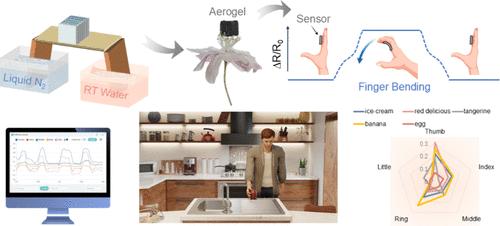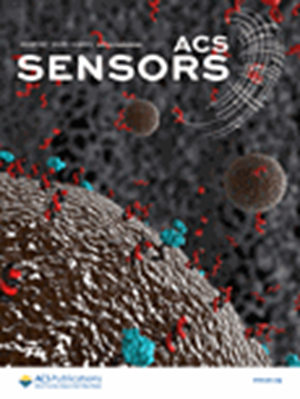Biomimetic Honeycomb-like Ti3C2Tx MXene/Bacterial Cellulose Aerogel-Based Flexible Pressure Sensor for the Human–Computer Interface
IF 8.2
1区 化学
Q1 CHEMISTRY, ANALYTICAL
引用次数: 0
Abstract
The pursuit of efficient and accurate human–computer interface design urgently requires high-performance sensors with pressure sensitivity, a wide detection range, and excellent cycling stability. Herein, a biomimetic honeycomb-like Ti3C2Tx MXene/bacterial cellulose (BC) aerogel with a negative Poisson’s ratio (ν = −0.14) synthesized from the bidirectional freeze-drying method is used as the active material for a flexible pressure sensor, which exhibits high sensitivity (20.14 kPa–1), fast response time (100 ms), excellent mechanical durability (5000 cycles), and a low detection limit (responding to a grain of rice weighing about 0.022 g). Moreover, when assembled into the sandwich-structured bending sensor with the aerogel layer at just 0.8 mm in thickness, the aerogel-based device has a wide angular detection range (2.7–156.3°), high sensitivity (0.47 deg–1), and good robustness, proving outstanding electromechanical performance. Significantly, a smart glove consisting of five bending sensors fixed to the proximal knuckles and a flexible circuit board as the signal processing unit was designed for the identification of the shape, demonstrating its promising applications in the field of human–computer interaction.

仿生蜂窝状Ti3C2Tx MXene/细菌纤维素气凝胶柔性人机界面压力传感器
追求高效、准确的人机界面设计,迫切需要具有压力灵敏度、检测范围广、循环稳定性好的高性能传感器。本文采用双向冷冻干燥法合成的仿生蜂窝状Ti3C2Tx MXene/细菌纤维素(BC)气凝胶,负泊松比(ν = - 0.14)作为柔性压力传感器的活性材料,具有高灵敏度(20.14 kPa-1)、快速响应时间(100 ms)、优异的机械寿命(5000次循环)和低检出限(对一粒重约0.022 g的大米响应)等特点。当气凝胶层厚度仅为0.8 mm的三明治结构弯曲传感器中组装时,气凝胶基器件具有宽角度检测范围(2.7-156.3°),高灵敏度(0.47°- 1)和良好的鲁棒性,证明了出色的机电性能。重要的是,设计了一种由五个弯曲传感器固定在关节近端,柔性电路板作为信号处理单元组成的智能手套,用于形状识别,展示了其在人机交互领域的应用前景。
本文章由计算机程序翻译,如有差异,请以英文原文为准。
求助全文
约1分钟内获得全文
求助全文
来源期刊

ACS Sensors
Chemical Engineering-Bioengineering
CiteScore
14.50
自引率
3.40%
发文量
372
期刊介绍:
ACS Sensors is a peer-reviewed research journal that focuses on the dissemination of new and original knowledge in the field of sensor science, particularly those that selectively sense chemical or biological species or processes. The journal covers a broad range of topics, including but not limited to biosensors, chemical sensors, gas sensors, intracellular sensors, single molecule sensors, cell chips, and microfluidic devices. It aims to publish articles that address conceptual advances in sensing technology applicable to various types of analytes or application papers that report on the use of existing sensing concepts in new ways or for new analytes.
 求助内容:
求助内容: 应助结果提醒方式:
应助结果提醒方式:


